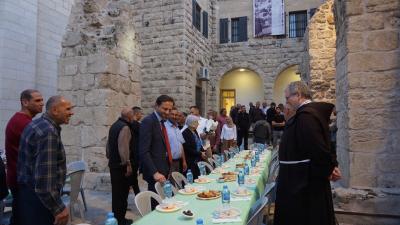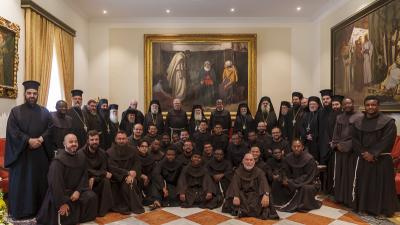
They arrived as a group at St. Savior for the first time and they were guided by Br. Alberto Pari, the Director of the Magnificat Music Institute who is also in charge of interreligious dialogue and relations with Israeli society. On February 8, the Franciscans of the Custody of the Holy Land welcomed the first group from a synagogue, which was also accompanied by Fr. Rafic Nahra, the patriarchal vicar for Hebrew-speaking Catholics.
Openness to the entire local population has always been a prerogative of the Franciscan mission in the Holy Land. Therefore, opening the doors of your “headquarters,” which is the St. Savior’s Monastery for the Franciscans of the Custody of the Holy Land, is a way to make yourself known and to show the fruits of your work.
The Keillat Zion group that visited the monastery has been working with the Jewish community and Br. Alberto for more than five years.
“It all started a few years ago when this community was just beginning and they were looking for Christian interlocutors who also spoke Hebrew," said Br. Alberto. “That’s when a friendship was formed between the rabbi in charge of the synagogue, Tamar Appelbaum, Br. Alberto and Fr. Rafic Nahra, and when the desire to create initiatives to meet and get to know each better began to make headway. Today the study of the Torah, the midrash and the Fathers of the Church is only one of the common activities, as is an “interreligious” charity center, where clothes and furniture are collected to give to Christians, Muslims and Jews who are in need.
Precisely because of this important collaboration that was established, visiting one of the places that represents the life of the Franciscans was a beautiful learning opportunity for the members of the Zion synagogue. Br. Alberto led the group to the Church of St. Savior, to the mother-of-pearl room, where ancient and precious objects made of mother-of-pearl and olive wood belonging to the Custody are on display. They also visited the refectory and the monastery’s terrace. Among the questions and the general interest, the Israeli friends showed enthusiasm and seemed to have enjoyed their visit.
Among the groups seeing the monastery for the first time, were also many young Israelis preparing for military service. During the year before serving in the army (mekhina, preparation), a visit to Jerusalem is planned to get to know the three great religions of the city: Judaism, Christianity and Islam. And the Franciscan friars of the Custody of the Holy Land are the ones responsible for introducing these young men to the Christian religion. Br. Alberto usually manages the meetings, sometimes assisted by friars who speak Hebrew, like Br. Clovis Bettinelli, Br. Marco Carrara and Br. Ayman Batesh, who, for example, helped out on February 14 with a group of Israelis, accompanied by two guides.
“I often come to St. Savior to bring groups of Israelis to visit the monastery,” said Aviv, a guide. There are groups of 30, 40 young men.” The Franciscans welcome them and offer their witness of life. “I told them about the spirituality of Jerusalem and how we Christians pray,” said Fr. Ayman. Usually many of the young men are impressed by the visit. “The young men are surprised by the gap between their mind and reality,” said Aviv, “because they were educated by hate, conflict and persecution, but then they meet real people. They know what the Crusaders did, but then they find the people they meet to be pleasant.”
For the Israelis it is interesting, because it is as if they were visiting another world: they discover a different language, and different buildings and clothes. “I believe the Custody is making a great effort to get closer to Israeli society. And it is a blessing to find someone who believes in the importance of having different communities come together,” concluded Aviv, the tour guide.




